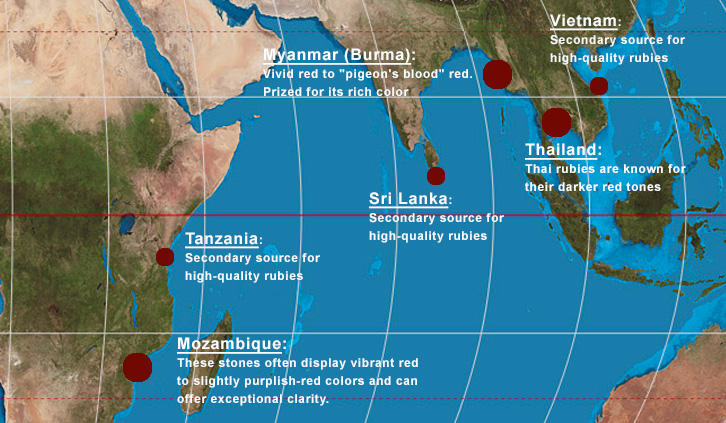Where are Rubies Found
Where Are Rubies Found?

Rubies are sourced from several renowned regions, each known for producing stones with distinct qualities that influence their color, clarity, and overall value:
Myanmar (Burma):
Burmese rubies, particularly those from the Mogok Valley, are widely considered the pinnacle of quality. These rubies are famed for their intense, saturated red hue known as pigeon’s blood—a pure, vivid red with a slight bluish tint that gives the gem a glowing inner fire. The crystalline limestone in Mogok is believed to contribute to the exceptional fluorescence and saturation of the rubies found there. Burmese stones often command premium prices, especially when untreated and of fine quality.
Mozambique:
Mozambique has emerged in the 21st century as a dominant force in the ruby market, supplying stones that rival even Burmese rubies in beauty. Rubies from Mozambique typically range from vibrant red to slightly purplish-red and can possess excellent transparency and size. The Montepuez region in northern Mozambique is one of the largest ruby deposits in the world, and stones from this region have attracted significant attention for their quality, availability, and ethical sourcing practices relative to other regions.
Thailand:
Thailand, particularly the Chanthaburi and Trat provinces, has long been a hub for ruby mining and trade. Thai rubies are known for their deeper, darker red coloration, often with brownish or garnet-like undertones due to higher iron content. While these stones may lack the vivid brightness of Burmese rubies, they are valued for their rich, velvety tones. Thailand is also a major cutting and treatment center, playing a key role in the global ruby industry beyond its own mining production.
Vietnam:
Vietnamese rubies, especially those from the Luc Yen and Quy Chau regions, can resemble Burmese rubies in color and fluorescence. They often exhibit a strong red hue with a pinkish or purplish undertone and can be quite beautiful, although they may be smaller in size and less consistent in quality. The deposits are relatively limited, making fine Vietnamese rubies somewhat rare.
Sri Lanka (Ceylon):
Rubies from Sri Lanka, historically referred to as Ceylon rubies, are typically lighter in tone, sometimes bordering on pink sapphires. They tend to have good clarity and brilliance, with a softer, more pastel red hue. Although they lack the saturated depth of Mogok or Montepuez stones, Sri Lankan rubies are appreciated for their gentle charm and are often well-cut due to the country’s strong gem-cutting tradition.
Tanzania:
Tanzania, particularly the Winza and Longido areas, produces rubies in a variety of hues, including bright red and purple-red. Winza rubies can be of very high quality, occasionally rivaling Burmese stones in terms of color and brilliance. However, many Tanzanian rubies are included or require treatment to enhance their appearance. Still, they remain a significant part of the global ruby supply chain and can offer excellent value for the quality.

| Country Origin | Typical Color | Notes |
|---|---|---|
| Myanmar (Burma) | Vivid red with a hint of blue (pigeon’s blood) | Considered the finest rubies; Mogok region is legendary for top quality. |
| Mozambique | Vibrant red to slightly purplish-red | Major modern source; Montepuez region known for large, clean stones. |
| Thailand | Dark red, often garnet-like | Higher iron content; darker tone can reduce brilliance slightly. |
| Vietnam | Strong red with pinkish or purplish undertones | Smaller stones; can resemble Burmese rubies in fluorescence. |
| Sri Lanka | Light red to pinkish-red | Good clarity; softer tones; sometimes classified as pink sapphires. |
